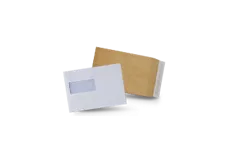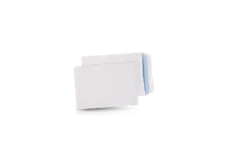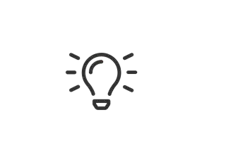Customer service
Our customer support is available every working day between 8am and 4pm.
Envelope Buying Guide

In this envelope buying guide, you will not only be able to locate the envelope you are searching for, but also gain information about the different types available. Our extensive assortment ranges from superior quality high white envelopes to cost-effective manila suitable for volume mailings. We aim to meet all your personal and professional mailing needs. You will find a selection of different weights, sizes, windows, and materials designed to provide specific benefits, like added protection or increased security.
Areas of Use
It is essential to think about what and to whom you will be sending your mail. This will determine what kind of features you will need. Will your mailings be of high volume or high quality? Will it contain just a single sheet of paper or bulky documents such as catalogues or small items. The below categories show which envelopes are suitable for which needs.
- Fast & easy
- Cost-effective & quality mailings
- Different degrees of whiteness
- Expandable side seam
- For bulky documents
- Convenient for e-commerce
- Weatherproof protection
- Lightweight & opaque
- Suitable for non-fragile items
- Ships safely & securely
- Protects delicate items
- Padded, bubble, & hardback
Formats & Sizes
There are several standard envelope sizes designed to accommodate different A-sized sheets. Our range carries a few of the standard formats which, for example, match a full A4 sheet of paper. Below are images that demonstrate which paper size fits in which envelope and whether they need to be folded. Also, the exact dimensions for each standard envelope format in millimetres can be found here. Besides the most popular envelope formats, we also offer other sizes and formats that are widely known.
The best choice when you want to send unfolded A4 sheets.
- 229 x 324 mm
- up to 5 sheets
- A4 unfolded
Widely used for daily business correspondence. Intended for A4 sheets that are folded into thirds.
- 110 x 220 mm
- up to 3 sheets
- A4 paper folded into thirds
Suitable for A4 sheets that are folded in half or unfolded A5 sheets.
- 162 x 229 mm
- up to 5 sheets
- A4 paper folded twice
Often used for informal mail and personal letters. Intended for A4 sheets that are folded into quarters.
- 114 x 162 mm
- up to 5 sheets
- A4 paper folder into quarters
A more specialist size intended to carry unfolded A3 sheets.
- 324 x 458 mm
- up to 5 sheets
- A3 paper unfolded
Ideal for unfolded A4 paper and is suitable for thicker documents.
- 250 x 353 mm
- 5-8 pages sheets
- A4 paper unfolded
Most suited for unfolded A6 sheets- use for photographs, art prints.
- 114 x 229 mm
- up to 6 sheets
- A4 paper folded into thirds
Sealing & Closure Types
There are different sealing types used for various types of different applications. Viking carries the most common sealing types, occasionally known as art of locks. There are three main closures.

Self-Seal Envelopes
An easy way to close your envelope is with a self-seal closure. With this method both flaps have a strip of latex that bonds together after pressing them firmly. The latex is derived from rubber and ammonium making this a natural seal. Furthermore, the latex on these self-seal envelopes have a guaranteed shelf life of at least 6 months from the date of manufacture.
View products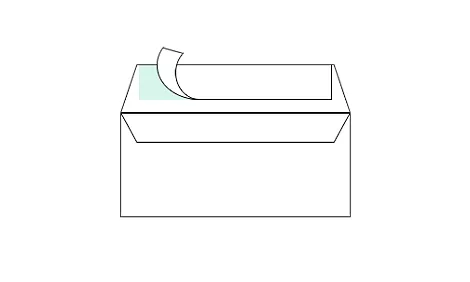
Peel & Seal Envelopes
The strongest seal to secure your envelope shut is with a peel and seal closure. With this method, the top flap is covered by a release tape that can be peeled away and then pressed down to form an instant bond. The glue hat is used on this envelope has a shelf life of up to 5 years.
View products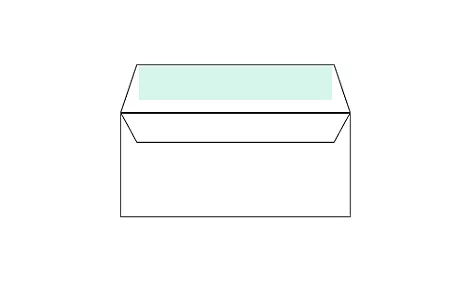
Gummed Envelopes
Gummed envelopes need to be moistened in order to be closed. Gummed envelopes are the only seal type which are suitable for machine inserting where the sealing is performed automatically. The gum used on the flap is water soluble and made from a mixture of dextrin and synthetic resin, making them biodegradable. If these envelopes are stored in moderate conditions where the temperature is not too hot or not too cold, these envelopes should last for a number of years.
View productsEnvelope Styles
Envelopes are offered in either a wallet or pocket style. A wallet style conveys the opening is on the long edge of the envelope, whereas pocket envelopes have their openings on the short side.
Open on the long edge.
Open on the long edge.
Windows
In our range, you will find both envelopes with windows and plain envelopes (without a window). Windows in envelopes are mainly used to display the name and address of the recipient on the form that is inside the envelope. If you are planning to buy an envelope with a window, be careful about its placement. Keep in mind where you want the postage stamp to go, and then choose one where the window is positioned to your liking.
Weight
At Viking, we carry a wide range of envelope weights which refers to the paper thickness. The most common standard weight is 80 or 90 gsm. This is a typical weight for all of your standard mailings. The paper weight of an envelope is measured in gram per square metres (g/m ² or gsm) and can be seen as a measurement of paper density, and thus an indicator of quality. This means, the lower the gsm, the thinner and lighter the envelope. If you want to post single-sheeted papers with low costs and a high volume, you could decide to go for a paper weight lower than 80 gsm. These are often brown or manila envelopes and are a more environmentally-friendly option due to the reduced amount of paper use per envelope. If you are planning to buy a more deluxe envelope, then our standard envelope range of 100/110/120 gsm is more suitable for your needs. For very important documents which need more protection, anything above 130 gsm would be ideal; these are classified as either board backed or gusset envelopes.
Colour
Using the right colour for your mailings can make all the difference. Our range consists of envelopes in various colours and tints so you can determine what connotations are attached to your mail. White is the most popular colour in envelopes. It is offered in many different shades and formats to specifically meet your personal needs. This is ideal for sending business letters as it is the most neutral, simple, yet professional option to give your receiver the appropriate message. Brown manila envelopes are also quite popular in our range. It is a darker colour and commonly used for either low cost mailings or filing and document keeping because of its less-transparent quality. Coloured envelopes are used for less frequent usage, such as marketing purposes, birthdays, and invitations. Red, pink, green, orange, and blue are just a few of the many shades available.
Sustainability
Not only are our recycled envelopes the sole sustainable solution. Most of the envelopes in our assortment have at least one environmental claim. Below is a short description to give you a better understanding of what each of these entail.

Recycled
Contains post-consumer and/or pre-consumer recycled content. Contains 100% recycled content (by weight).

FSC® Certified
Products originating from certified well managed forests.
FSC certification promotes environmentally appropriate, socially beneficial, and economically viable management of the world's forests through third party verification of the supply chain.
Quality or Production Type related Attributes

TCF & ECF
ECF (Elementary Chlorine Free) and TCF (Totally Chlorine Free). Indicating whether a product is manufactured from chlorine free paper and the paper is made from virgin fibre that is either unbleached or bleached without harmful derivatives.
- 65% of people give printed mail their full attention, compared with only 35% that said the same regarding emails
- 70% of people state receiving mail creates a better impression of the company in comparison to receiving email
- 70% of people feel more valued when receiving postal mail
- People value something 24% more when they can touch and feel it rather than just see it
- 7 out of 10 people prefer to receive legal or banking information in the form of a letter
- Almost 50% of people prefer to receive sales information via a letter or brochure, closely followed by email, cited by 42.8%. Less than 7% like to receive sales information face-to-face
- Almost two thirds (63%) of consumers take mail more seriously than email
- Direct marketing campaigns that include mail are 27% more likely to deliver top-ranking sales performance, and 40% more likely to deliver top-ranking customer acquisition levels than campaigns without mail
- An average of 23% of all mail is shared between people in a household. 21% of promotions and special offers are shared
- Mail is kept in a household for an average of 17 days for advertising mail, 38 days for door drops and 45 days for bills and statements
- Printed mail grabs attention, is considered and informative, makes its recipient feel valued, and gives a better impression
- Compared with other media, mail recipients experiences higher levels of emotional engagement and remember more
- Picking up a pen and paper can be therapeutic
- Consumers are more likely to deal with direct mail immediately compared to email


